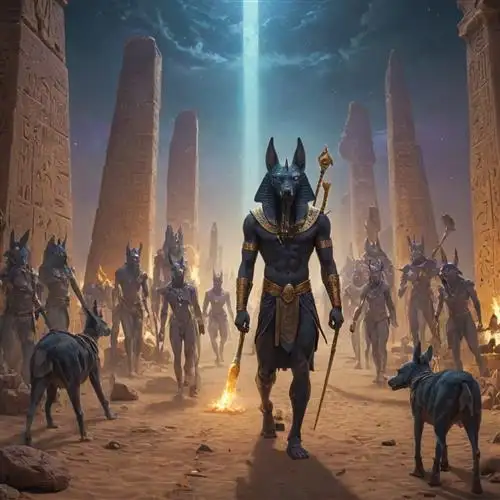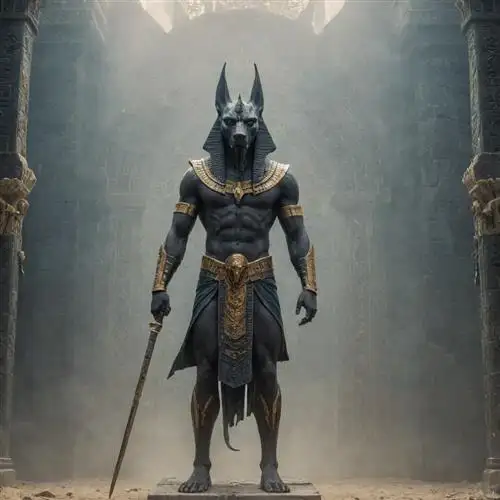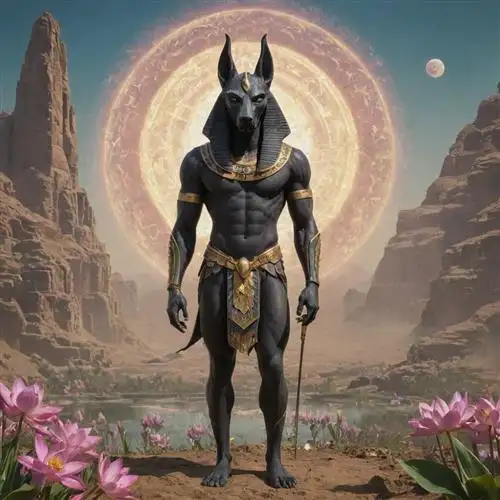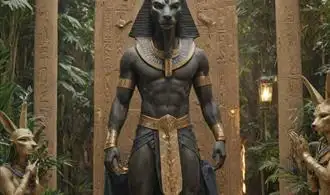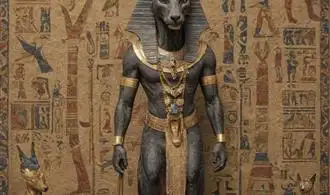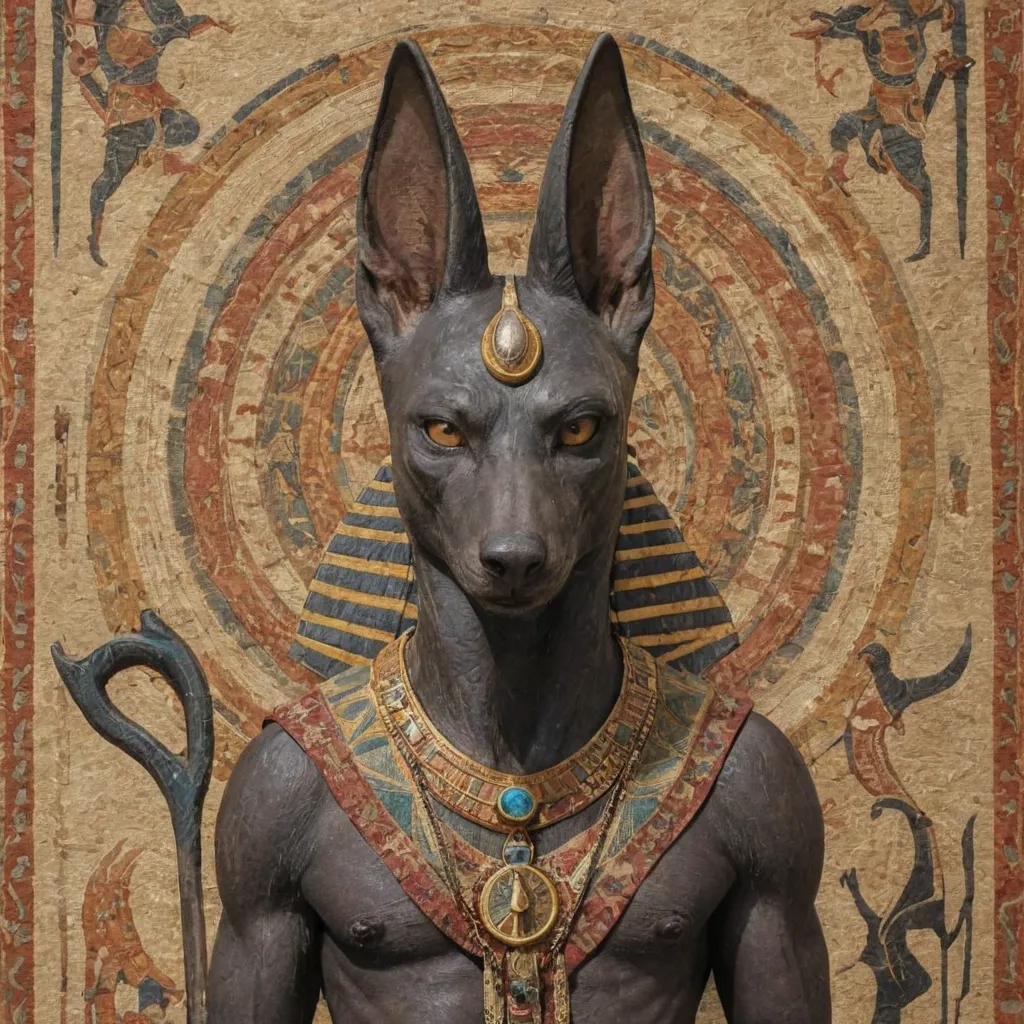
The Significance of Anubis in Ancient Egyptian Mythology
Anubis, the jackal-headed deity, was a central figure in ancient Egyptian mythology, exerting a profound influence on the religious beliefs and practices of the civilization. As the god of the dead, embalming, and the afterlife, Anubis played a crucial role in the complex and intricate system of funerary rites and rituals that were so integral to ancient Egyptian culture.
One of the primary functions of Anubis was as the guide and protector of the deceased on their journey to the afterlife. Believed to be the son of Ra, the sun god, and Nephthys, the goddess of mourning, Anubis was responsible for overseeing the process of mummification and ensuring the safe passage of the deceased through the dangerous realms of the underworld.
In the famous "weighing of the heart" ceremony, Anubis was depicted as presiding over the judgment of the dead, where the heart of the deceased was weighed against the feather of truth. This ritual was a critical component of the ancient Egyptian conception of the afterlife, as it determined whether the individual would be granted eternal life in the hereafter or condemned to oblivion.
Anubis was also associated with the protection of graves and funerary temples, and was often depicted as guarding the entrances to these sacred spaces. His presence was meant to ward off any malevolent spirits or forces that might threaten the resting place of the dead, further underscoring his importance as a guardian of the afterlife.
Moreover, Anubis was closely connected to the embalming process, with his jackal-like appearance linking him to the mummification of the deceased. The ancient Egyptians believed that Anubis presided over the preparation of the body for the afterlife, ensuring that the deceased was properly preserved and ready to undertake their journey to the next world.
The symbolism of Anubis was not limited to the realm of the dead, however. He was also associated with healing and the protection of the living, particularly in the context of dangerous or hazardous situations. This dual nature, as both a guardian of the dead and a protector of the living, further emphasizes the profound significance of Anubis in ancient Egyptian mythology.
Anubis as the Gatekeeper to the Afterlife
The symbolism of Anubis, the ancient Egyptian jackal-headed deity, holds profound significance that extends far beyond the surface-level depictions often associated with this powerful figure. As the gatekeeper to the afterlife, Anubis played a crucial role in the beliefs and rituals of ancient Egyptians, guiding the souls of the deceased through the complex journey towards the afterlife.
Anubis was responsible for the critical process of mummification, ensuring the preservation of the physical body for the soul's return. This intricate practice was not merely a means of preserving the deceased but a sacred ritual that symbolized the transformation from mortal to immortal. Anubis's role as the embalmer and protector of the dead solidified his position as a central figure in the Egyptian pantheon, guiding the departed through the treacherous passage to the afterlife.
Beyond his role as the embalmer, Anubis was also believed to be the guardian of the Weighing of the Heart ceremony, a critical moment in the journey to the afterlife. In this ritual, the deceased's heart was weighed against the feather of Ma'at, the goddess of truth and justice. Anubis would preside over this judgment, ensuring the soul's worthiness to pass into the afterlife. This symbolic act underscores the profound importance of Anubis as the gatekeeper, responsible for determining the fate of the departed.
Anubis's association with the afterlife also extended to his role as the protector of the tombs and the guardian of the necropolis. The jackal-headed deity was often depicted standing atop the entrances to tombs, symbolizing his watchful gaze over the resting places of the deceased. This belief in Anubis's protective powers reinforced the idea that he was a crucial figure in ensuring the safe passage of the soul to the afterlife.
The Mummification Process and Anubis's Role
Anubis, the jackal-headed deity, played a pivotal role in the mummification process, a sacred ritual that was integral to ancient Egyptian beliefs about the afterlife. As the god of embalming and the protector of the dead, Anubis oversaw the meticulous process of preserving the physical body, ensuring the deceased's successful passage to the next world.
The mummification process was a complex and lengthy procedure that involved several stages. Anubis's involvement began with the initial step of removing the internal organs, which were placed in canopic jars under the protection of four different deities. The body was then packed with natron, a salt-like substance that drew out the moisture, effectively drying and preserving the remains.
Anubis was responsible for the crucial step of removing the brain through the nose, a delicate operation that required great skill and precision. The brain was considered unnecessary for the afterlife, and its removal was an integral part of the mummification ritual. Anubis's jackal-like appearance and association with death and the underworld made him the ideal deity to oversee this solemn task.
Once the body had been properly prepared, Anubis played a crucial role in the final stages of the mummification process. He was believed to be present during the wrapping of the body in linen bandages, ensuring the protection and preservation of the deceased. The wrapping process was a meticulous and symbolic act, with each layer representing a specific aspect of the individual's journey to the afterlife.
Anubis's role in the mummification process was not limited to the physical aspect of preservation. He was also believed to guide the soul of the deceased through the perilous journey to the underworld, where the heart would be weighed against the feather of truth. This complex ritual, known as the 'Weighing of the Heart,' determined the fate of the individual in the afterlife, and Anubis's presence was crucial in ensuring a successful outcome.
Anubis as a Symbol of Transformation and Rebirth
Anubis, the jackal-headed Egyptian god, has long been revered as a symbol of profound significance, far beyond his traditional role as the guardian of the dead. Delving deeper into the symbolism of Anubis unveils a multifaceted deity whose essence transcends the realms of mortality and guides the process of transformation and rebirth.
At the core of Anubis' symbolism lies his intimate connection with the process of mummification and the journey of the soul into the afterlife. As the protector of the dead, Anubis presided over the crucial step of embalming, ensuring the preservation of the physical form and the safe passage of the individual's spirit. This role, however, extends far beyond the literal act of mummification, for Anubis' influence encompasses the metaphorical transformation that occurs within the human experience.
The jackal-headed god is often depicted as the psychopomp, the guide who shepherds the deceased through the treacherous underworld, navigating the challenges and obstacles that stand between the physical and the spiritual realms. This symbolic journey mirrors the inner transformations that individuals undergo throughout their lives, as they confront the daunting task of shedding the old to embrace the new.
Anubis' presence as a guide and protector during this transformative process is paramount. His watchful gaze and unwavering support serve as a beacon of hope, reminding us that even in the darkest of times, there exists the potential for rebirth and renewal. The act of mummification, with Anubis presiding over the ritual, symbolizes the shedding of the physical form to allow the spirit to emerge, reborn and rejuvenated.
Moreover, Anubis' association with the underworld and his role as the weigher of the heart during the final judgment of the dead further solidify his significance as a symbol of transformation. The weighing of the heart, a crucial step in the journey to the afterlife, represents the ultimate test of one's moral and spiritual purity. It is Anubis who oversees this profound moment, ensuring the integrity of the process and guiding the individual towards their rightful place in the afterlife.
In this capacity, Anubis becomes a symbol of the transformative power of self-reflection and personal accountability. The individual's willingness to confront their own flaws and shortcomings, to weigh their actions against the standards of righteousness, is a testament to their readiness for the next phase of their spiritual evolution.
The Iconography and Artistic Representations of Anubis
Anubis, the ancient Egyptian god associated with mummification and the afterlife, has a rich and intricate iconography that has captivated scholars and enthusiasts alike. As one of the most prominent deities in the Egyptian pantheon, Anubis' visual representations offer a glimpse into the beliefs, cultural practices, and artistic traditions of this ancient civilization.
Typically depicted with the head of a jackal or a black dog, Anubis' iconography is instantly recognizable. This distinctive feature symbolizes the god's role as the protector of the dead and the guardian of the mummification process. The black color of Anubis' head is thought to represent the color of the fertile soil along the Nile River, which was seen as a symbol of regeneration and rebirth.
In artistic depictions, Anubis is often shown in a seated or standing position, holding various ritual objects associated with his role in the afterlife. These may include the crook and flail, symbols of authority and divine power, or the ankhsymbol, representing life and the cycle of rebirth. Anubis may also be shown performing specific funerary rituals, such as the "Opening of the Mouth" ceremony, which was believed to restore the deceased's ability to speak, breathe, and partake of offerings in the afterlife.
The artistic representations of Anubis extend beyond the traditional anthropomorphic depictions. In some cases, the god is shown as a full jackal or dog, reflecting his animal-like attributes and his association with the natural world. Additionally, Anubis may be depicted in a hybrid form, with a human body and a jackal head, further emphasizing his dual nature as both a divine and a bestial entity.
The placement and positioning of Anubis in Egyptian art are also significant. The god is often shown guarding the entrances to tombs or temples, symbolizing his role as a protector of the dead and the gatekeeper to the afterlife. Anubis may also be depicted alongside other deities, such as Osiris or Isis, highlighting his importance within the broader Egyptian pantheon and his connections to the complex web of religious beliefs and practices.

